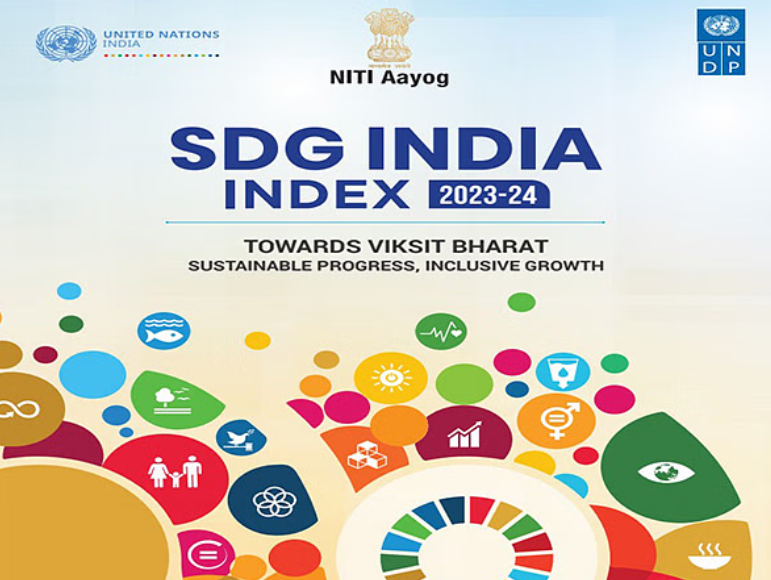NITI Aayog SDG India Index 2023-24 (GS Paper 2, Inclusive Growth)

Overview
- The latest Sustainable Development Goal (SDG) India Index for 2023-24 has been released by NITI Aayog, showcasing substantial advancements in sustainable development across Indian states and union territories.
SDG India Index Explained
- Purpose: The SDG India Index is a tool developed by NITI Aayog to measure and track India’s progress towards the United Nations’ Sustainable Development Goals (SDGs). It encourages states to incorporate these goals into their development agendas and helps identify gaps and prioritize actions to achieve sustainable development by 2030.
- Methodology: The Index evaluates states and union territories on 16 out of 17 SDGs, excluding Goal 14 (Life Below Water), which pertains only to coastal states. It uses 113 indicators aligned with the National Indicator Framework. Scores range from 0-100, with higher scores indicating better progress towards SDG targets. States/UTs are categorized into Aspirant (0-49), Performer (50-64), Front-Runner (65-99), and Achiever (100).
- Impact: The Index fosters competitive and cooperative federalism, encouraging states and UTs to learn from each other. It highlights achievements and areas needing improvement, integrating SDGs into national development strategies and supporting the vision of Viksit Bharat @ 2047.
Key Highlights of SDG India Index 2023-24
- Overall Progress: India’s overall SDG score improved to 71 in 2023-24, up from 66 in 2020-21 and 57 in 2018. This progress is attributed to targeted government interventions in areas like poverty reduction, economic growth, and climate action.
- Top Performers: Kerala and Uttarakhand emerged as the top-performing states with scores of 79 each.
- Lowest Performer: Bihar scored the lowest with 57 points, followed by Jharkhand at 62 points.
- Front-Runner States: 32 states and UTs fall under the front-runner category, with 10 new entrants including Arunachal Pradesh, Assam, Chhattisgarh, and Uttar Pradesh.
Government Interventions and Their Impact
- Pradhan Mantri Awas Yojana: Over 4 crore houses built.
- Swachh Bharat Mission: 11 crore toilets and 2.23 lakh community sanitary complexes constructed.
- Ujjwala Yojana: 10 crore LPG connections provided.
- Jal Jeevan Mission: Tap water connections in over 14.9 crore households.
- Ayushman Bharat-PMJAY: Over 30 crore beneficiaries.
- PM Mudra Yojana: 43 crore loans sanctioned.
- Saubhagya Scheme: 100% household electrification.
- Renewable Energy: Solar power capacity increased from 2.82 GW to 73.32 GW in a decade.
- National Food Security Act (NFSA): Coverage of over 80 crore people.
- Direct Benefit Transfer (DBT): Rs. 34 lakh crore transferred via PM-Jan Dhan accounts.
- Skill India Mission: Over 1.4 crore youth trained and upskilled, 54 lakh reskilled.
Specific SDG Highlights
- Goal 1: No Poverty: Improved score from 60 (2020-21) to 72 (2023-24). Employment under MGNREGA offered to 99.7% of those demanding it.
- Goal 2: Zero Hunger: Score improvement from Aspirant to Performer category. 99.01% beneficiaries covered under NFSA, 2013.
- Goal 3: Good Health and Well-being: Score improved from 52 (2018) to 77 (2023-24). 93.23% children fully immunized, Maternal Mortality Rate at 97 per 100,000 live births.
- Goal 4: Quality Education: Adjusted Net Enrolment Rate (ANER) for elementary education at 96.5% (2021-22). 88.65% of schools have access to both electricity and drinking water.
- Goal 5: Gender Equality: Score improved from 36 (2018) to 49 (2023-24). Sex ratio at birth stands at 929 females per 1,000 males.
- Goal 6: Clean Water and Sanitation: Significant score improvement from 63 (2018) to 89 (2023-24). 99.29% of rural households have improved drinking water sources.
- Goal 7: Affordable and Clean Energy: Highest score among all SDGs, from 51 (2018) to 96 (2023-24). 100% household electrification under Saubhagya Scheme.
- Goal 8: Decent Work and Economic Growth: 5.88% annual growth rate of GDP per capita (2022-23). Unemployment rate reduced from 6.2% (2018-19) to 3.40% (2022-23).
- Goal 9: Industry, Innovation, and Infrastructure: Score improved from 41 (2018) to 61 (2023-24). 99.70% of targeted habitations connected with all-weather roads under PM Gram Sadak Yojana.
- Goal 10: Reduced Inequalities: Score decreased from 67 (2020-21) to 65 (2023-24). 45.61% of Panchayati Raj Institution seats held by women.
- Goal 11: Sustainable Cities and Communities: Score improved from 39 (2018) to 83 (2023-24). Municipal solid waste processing increased from 68% (2020) to 78.46% (2024).
- Goal 12: Responsible Consumption and Production: 91.5% of biomedical waste treated in 2022. 54.99% hazardous waste recycled/utilized (2022-23).
- Goal 13: Climate Action: Score improved from 54 (2020-21) to 67 (2023-24). 43.28% of electricity generated from renewable energy (2024).
- Goal 14: Life on Land: Score improved from 66 (2020-21) to 75 (2023-24). 25% of geographical area under forests and tree cover.
- Goal 15: Peace, Justice, and Strong Institutions: 95.5% of population under Aadhaar coverage (March 2024). 71.3% charge sheeting rate of IPC crimes (NCRB 2022).
Conclusion
- The SDG India Index 2023-24 reflects India’s ongoing commitment to achieving the Sustainable Development Goals.
- Through targeted interventions and collaborative efforts, significant progress has been made across various sectors.
- However, challenges remain, especially in areas like gender equality and reducing inequalities.
- The Index serves as a valuable tool for policymakers to strategize and prioritize actions, ensuring inclusive and sustainable development for all by 2030.


